----------------------------------------------------------------------------------------------------------------------------------------------
ABBADIA MONTEOLIVETO MAGGIORE
One of the most attractive places in the Senese to visit: a monastery with a delightfully frescoed cloister set in a cypress grove in a spectacular hilly landscape.
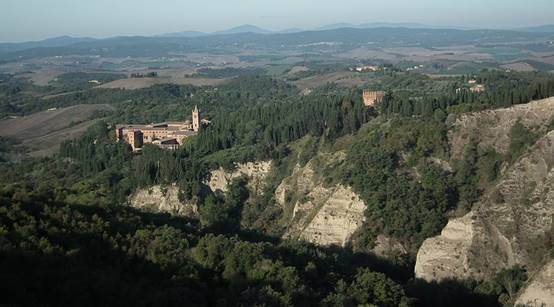
Photo by Acer 11 via wikimedia
About an hour from Barontoli. The road to Monteoliveto turns off the SS 2 (via Cassia) at Buonconvento. The SS 2 Cassia can be reached by going up to Siena, or else by a beautiful drive across the mountains. To go the latter way, drive through San Rocco onto the main Grosseto road. After about 8 km turn left towards Fontazzi. Go through Fontazzi to Casciano di Murlo and turn right at the T-junction towards Vescovaldo di Murlo. After about two kilometers, turn right towards Vescovaldo di Murlo and SS 2 Cassia, and continue following signs to Vescovaldo di Murlo. When you reach Vescovaldo, drive through the village and start following signs to Buonconvento. When you enter the small town of Buonconvento, go straight ahead until you come out on to the SS 2 Cassia. Turn left onto the Cassia and then right to Monteoliveto, up a winding road through the “creti”, spectacular bare grey clay hills (reminiscent of the country through which Guidoriccio da Fogliano rides in the famous fresco in the Palazzo Pubblico) until you come to the red-brick monastery in its forest of pines and cypresses. Open 09.15-12.00 and 15.15-17.45 (17.00 in winter).
After parking the top (disabled people can drive down to the bottom), walk across the drawbridge and through the battlemented gatehouse decorated on each side with della Robbia style terracotta plaques – the Madonna and Child with Angels on the outside and St Benedict on the inside. There is then a choice of descents through the cypresses to the monastery: the old rough brick path straight ahead and the winding new road able to take cars on the right. Halfway down is the monks’ fishpond, dating from 1533, now with only a little stagnant water in it.
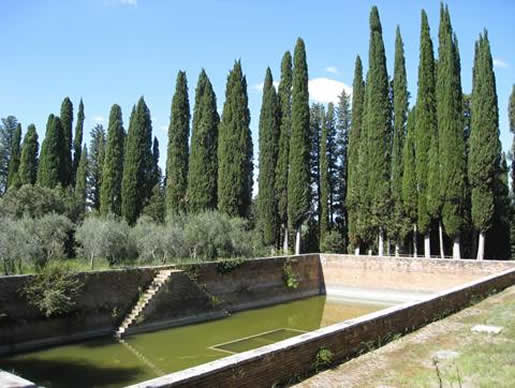
The great redbrick monastery at the bottom was founded by a Sienese nobleman, Giovanni Tolomei, who deserted the riches of Siena in 1313 for the simple life and started the “Olivetan” order of monks under Benedictine rule. The monastery remained in being until it was suppressed by Napoleon in 1810. There are now monks there again, but only a few; they specialise in restoring ancient manuscripts.
The cloister
The 15th century cloister is on the right, beyond the church. Its walls are covered with a marvellous cycle of frescoes depicting the life of St Benedict (who lived from about 480 to 550) as retailed by his near contemporary, St Gregory the Great. They are full of fascinating and lively detail. Eight of the 36 are by Luca Signorelli (1441-1523) who worked on them from 1497-8. He was originally commissioned to do the whole lot but got bored and walked off the job part way through. The remainder are by Il Sodoma (1477-1549) and were painted between 1505-8.
The cycle starts on the left of the far wall opposite the entrance (next to the entrance into the church, as that would have been the monks’ normal entrance to the cloister). Each fresco has its title underneath in Italian. The first frescoes are all by Sodoma and are:
1. Benedict leaving home in Norcia as a young man to study in Rome, with his parents on the left bidding him a sorrowful good-bye, and his faithful nurse on a donkey ready to accompany him.
2. Benedict leaving the college in Rome – which he found too hedonistic - to withdraw to a life of prayer (he can be seen creeping out on the right).
3. Benedict miraculously mends a broken tray (according to legend, his nurse had borrowed the tray to pick through some grain and had broken it; the woman who owned the tray began to weep and Benedict, touched, prayed to God and the tray was mended). The swashbuckling young man in the foreground with the white gloves is a self-portrait of Sodoma with some of the animals he adopted to keep him company while he was painting the cloister.
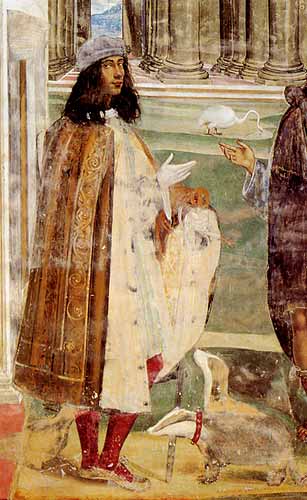
4. The holy monk Romano gives Benedict a hermit’s habit. The town in the background is Subiaco, where Benedict founded his first monastery. This and the next fresco have some of the best scenery.
5. Benedict at prayer in front of the cave in which he lived during his three years as a hermit; and the devil hurling a stone (from top left) and breaking the bell of Benedict’s bread basket. The monk Romano used to lower food to Benedict in this basket, ringing the bell to warn him it was coming. The devil apparently became so irritated by all this holy hermitry that he decided to destroy the bell.
6. A priest (on the right, looking up) is inspired by Christ to take a meal (complete with servitor) to Benedict (still being a hermit in the desert) on Easter day. Note how Benedict’s designer stubble in the previous fresco is growing and will soon be a flowing beard.
7. Benedict preaches to a group of peasants.
8. Benedict overcomes temptation – in the form of a beautiful horned woman hovering above – by throwing himself naked into some brambles (right), while the Archangel Michael chases the temptress away. The left of the picture shows him struggling visibly with the temptation: rather a good bit of characterisation by Sodoma.
9. Benedict agrees to an invitation from a group of hermits to become their superior, thus beginning his monastic career. Their hermitage can be seen in the background.
10. Benedict – by making the sign of the cross – shatters a glass of wine that has been poisoned by some of his monks who found his monastic rule too strict. The monks can be seen preparing the poisoned drink at the end of a corridor.
11. Benedict founds twelve communities of monks – note the interesting illustration of mediaeval building techniques.
12. Benedict welcomes two youths, Mauro and Placido, into the order – they have arrived from Rome accompanied by an impressive retinue of family and followers.
13. Benedict chases the devil from a monk who has become possessed, by beating him (on the right). The possession seems to have taken the form of following the devil’s invitation to go for a walk outside the monastery – see in the middle the devil pulling the robe of the errant monk. To the top right Benedict can be seen forgiving the monk while the frustrated devil above flees the scene.
14. After having been entreated by the monks (in the left hand corner), who do not have enough water for their needs, Benedict produces water from the mountain.
15. Benedict retrieves the blade of a scythe which has become detached from its handle (left) and fallen into a lake – see how it miraculously reattaches itself to its handle (middle).
16. Mauro is sent to save Placido from drowning, walking miraculously on the water to do so. On the left, Benedict, who has had a miraculous vision of the accident, is telling Mauro to go to the lake.
17. (Over the door) Benedict changes a flask of wine into a serpent. An errand boy was supposed to deliver two flasks but hid one on the way. On the left he delivers the remaining one, and on the right he goes back to recover the other only to find the wine transformed into a serpent.
18. The wicked monk Fiorenzo (Florentius), envious of Benedict’s reputation, tries to poison Benedict with a poisoned loaf, but Benedict realises what he is doing and gives the bread to a crow with a request to the crow that it carry the bread far away where it will harm no-one.
19. Fiorenzo’s next exploit is to send a number of loose women into the monastery to tempt the monks. Sodoma originally painted them naked, but the abbot of the time was so shocked that he forced Sodoma to paint clothes on them. Benedict sees them coming from the balcony above, and decides to take all the monks off on an expedition to avoid temptation (bottom left).
20. Benedict sends Mauro to France and Placido to Sicily on missions of evangelisation. This fresco is by Bartolomeo Neroni, also called Il Riccio, who was Sodoma’s son-in-law.
The next eight frescoes on this wall are by Luca Signorelli. Given that they were painted before Sodoma came on the scene, it is strange that Signorelli chose to begin in the middle of St Benedict’s life. Signorelli’s style is less pretty but more powerful and spiritual than Sodoma’s, with no pet animals to distract from the main theme.
21. God causes Fiorenzo’s death by making a house collapse on top of him. Devils can be seen raging against the falling building at top left and carrying off his soul at the top right. In the foreground a monk comes to tell Benedict the news, but Benedict reproves him for showing too much pleasure at Fiorenzo’s death.
22. Benedict converts the inhabitants of Montecassino. The monks in the background are pulling down a statue of Apollo, still worshipped there when Benedict arrived (shades of the toppling of Saddam Hussein’s statue in Baghdad).
23. Benedict defeats the devil with the sign of the cross – the devil had bewitched a block of stone being used to build a monastery, making it too heavy to lift.
24. Benedict brings back to life a young monk on whom a wall had collapsed. The accident is seen happening top left, with the lifeless monk being carried to St Benedict below.
25. Benedict catches out two monks who are dining outside the monastery without permission. When they returned to the monastery and were asked where they had gone, thinking themselves undetected they replied “nowhere”, but Benedict (top right) was miraculously able to tell them exactly where they had been.
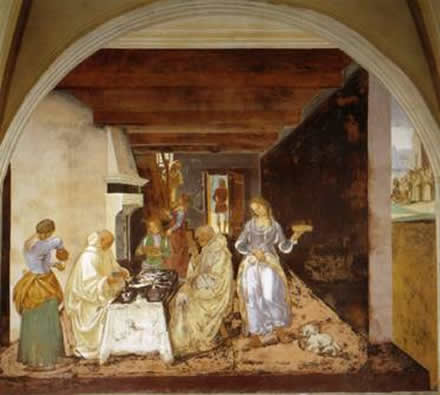
26. Benedict reproaches the brother of the monk Valerian for having broken his fast after being tempted by a wayfarer (on the right).
27. Benedict unmasks Riggo, who had disguised himself as Totila, king of the Goths. Riggo was Totila’s shield-bearer and had been sent in disguise by Totila to see if Benedict really had holy powers or could be deceived by the disguise. The scene at the top shows Riggo back at Totila’s campsite telling him what happened.
28. Benedict recognises and receives Totila, who has come in person to make amends for his failed attempt at deception.
The next fresco was destroyed when the door was enlarged. The following ones are again by Sodoma.
29. Benedict foretells the destruction of Montecassino (by the Lombards in 581, the first of many destructions). Benedict is at the top right.
30. Benedict miraculously obtains flour for his monks. Flour had been running short at the monastery, but Benedict told the monks not to despair and the next day sacks of flour duly arrived (on the left). It is unclear whether the meal on the right is before or after the flour arrived; the provisions certainly look a little sparse.
31. Benedict appears to two far-away monks in their sleep and tells them how to build a monastery.
32. Benedict first excommunicates two nuns for bad behaviour and then absolves them after their death. A somewhat curious scene: the two women were buried in consecrated ground next to the church and, during mass (being celebrated in the centre of the picture), at a point where the deacon asks excommunicated people to leave, the nuns rise from their tombs (left). The subsequent absolution is shown on the other side.
33. Benedict has the Sacred Host placed on the body of a monk that the ground had refused to receive – the ground had apparently done this because the monk, before dying, had disobeyed Benedict.
34. Benedict forgives a monk who had fled from the monastery – the monk had come back to the monastery after meeting a monster on the road (on the right).
35. Benedict miraculously releases with a look a man who had been tied up by a Goth (Goths were all-purpose enemies at the time). The Goth wanted the man to hand over his belongings (in the background on the right), but he said that he had given them to Benedict. The Goth drags him to Benedict’s monastery and reiterates his demand, whereupon Benedict exercises his miraculous glance.
The church
Beyond this last fresco a passage (decorated with more frescoes by Sodoma) leads into the church, built between 1400 and 1417 in the gothic style. The best things in it are the choir stalls, decorated with the most beautiful inlaid wood – 16th century “intarsia” work – scenery, birds and animals. There is more intarsia on the lectern in the middle, including a wonderful and much reproduced tabby cat. One of the three chapels contains a large wooden crucifix brought to the monastery by its Tolomei founder in 1313; the crucifix allegedly spoke to Tolomei on a number of occasions.
The Library
For a long time, the Library was closed because visitors had stolen some of the rare documents from it. But it has now been reopened and can be reached up a stairway from the cloister, although most of the manuscripts are now securely locked away. Up some stairs at the end of the room there is an exceptional collection (because so complete) of blue and white pottery medicine jars from the monastery’s pharmacy. Rooms off the library have a mediocre collection of paintings, although there is one room of quite attractive water-colours of Monteoliveto itself.
There is quite a good little restaurant with a pleasant terrace at the top of the monastery drive, called La Torre (closed on Tuesdays).
______________________________________________________________________
SAN GIOVANNI D’ASSO
If you are not sated with sightseeing after Monteoliveto, go on up the road to the village of San Giovanni d’Asso (through Chiusure and right at the T-junction). San Giovanni has an attractive castle. From the village car-park one can wander in through the main gate, noticing the remains of Gothic windows; walk through a courtyard with a renaissance brick loggia; and leave through the door on the other side, emerging into a little square with spectacular views to the right (and also a small Romanesque church).
One can then return through the castle and follow the signs from the car-park to the village, where there is another Romanesque church, San Piero in Villore. Its ancient façade is decorated with blind arches and strange primitive sculptures – the stone to the left of the door has a particularly macabre scene of two wolves each eating an arm of an unfortunate man trapped between them. Up the main street there is a bar with a panoramic view.

San Pietro in Villore
1994, revised 2004
---------------------------------------------------------------------------------------------------------
ASCIANO
A town in the middle of the dramatic Crete landscape with an excellent small museum.
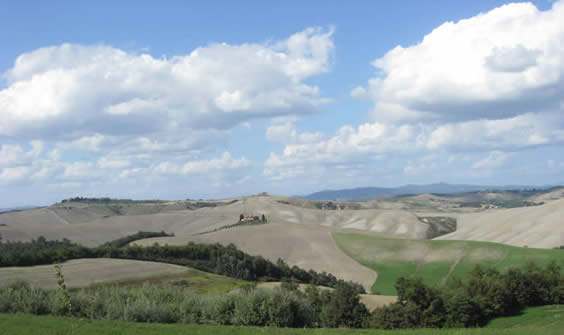
The grey soil of the Crete
Asciano is – and probably has been since Etruscan times – the ancient market town of the Crete area, the grey clay hills across which Guidoriccio da Fogliano rides in the famous fresco in the Palazzo Pubblico in Siena. Whichever way the town is approached, the landscape is spectacular, the bare hills interrupted only by chasms of erosion and the occasional line of cypress trees along the horizon.
Asciano has one long main street, the Corso Matteotti. At the top end there is the main church, the Collegiata or Basilica di Sant’ Agata, up a broad flight of steps. It is on the hinge of Romanesque and Gothic, and is built entirely of travertine marble. There is nothing particularly special about it; it is just a very attractive church, both outside and in (look particularly at the inside of the dome). There is one good fresco, on the right wall, of the Madonna and Child with St Michael the Archangel, attributed to Girolamo del Pacchia (c.1477-after 1533), a contemporary of Sodoma.
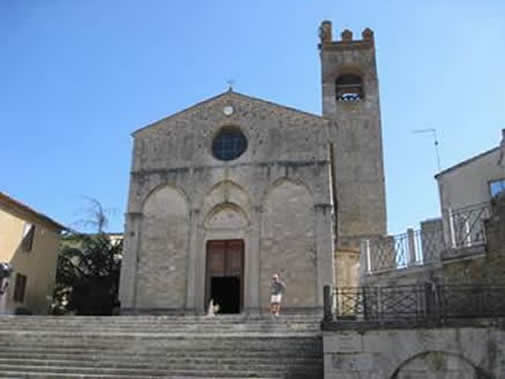
Collegiata
Just beyond the Collegiata, there is a Carabinieri station which is an excellent example of the architecture of the Mussolini period.
Halfway down the main street there is a red-brick clocktower, the Torre Civica, medieval in origin but much restored. The road beside the clock-tower, via Cassioli, leads down to a small open space, the Piazza del Grano, with an attractive 15th century travertine fountain. Back in the main street, opposite the Torre Civico, there is a chemist’s shop. This building, which like so many in Tuscany has Roman foundations, secretes a Roman mosaic, much pictured on posters. The chemist will show it to visitors on request.
Further down the main street, just beyond the church of San Agostino at No. 122, an ancient palazzo, the Palazzo Corboli, has been transformed into one of the best small museums in Tuscany, taking in the collections from two previous museums (of Sacred Art and Archaeology) which were both boringly laid out and hardly ever open. This Museum of Sacred Art and Archaeology is open every day except Monday from 1000-1300 and 1500-1900 (1030-1300 and 1500-1730 from November to March). It has quite good English captions.
The ground floor has a room devoted to the history of the palazzo, fascinating as it shows how this ancient building (it dates from the early 1200s), like so many in Tuscany, was restructured over the years to suit the needs of subsequent generations without ever losing its essential character. The room also contains the old cess-pit of the palazzo and a show-case of the detritus found within it (old potsherds etc.).
The first floor has a maze of small rooms, including some with part of their original late 13th century frescoes, giving a good idea of how the walls of mediaeval palazzi were decorated. The best is the so-called Sala di Aristotele (Aristotle), covered with panels painted to look like marcle. It takes its name from one of the roundels on the wall depicting Aristotle with his name on a scroll beneath. The other roundels depict Virtues (Prudence, Justice, Strength and Temperance) and various mythological or biblical figures. In a further room, there is a particularly good ceiling with frescoed panels of the four seasons – Winter is unusually represented by a man holding a snow-ball.
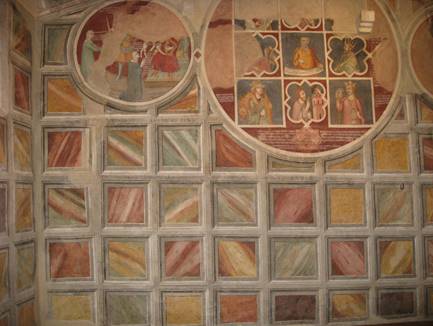
Room with medieval frescoed walls
Above all, however, this floor contains a small selection of mainly exquisite works of art. The chef d’oeuvre of the collection, a spirited tryptich by Ambrogio Lorenzetti (c.1290-1548) of St Michael the Archangel (a favourite Asciano subject, it seems) slaying a colourful multi-headed dragon. St Michael is flanked by St Bartholomew on the left and St Benedict on the right, both with marvellously expressive faces – note particularly the wise old face of St Benedict. Above there is an exquisite Virgin and Child, reminiscent of the one by the same artist in the Oratorio St Bernardino in Siena (qv).
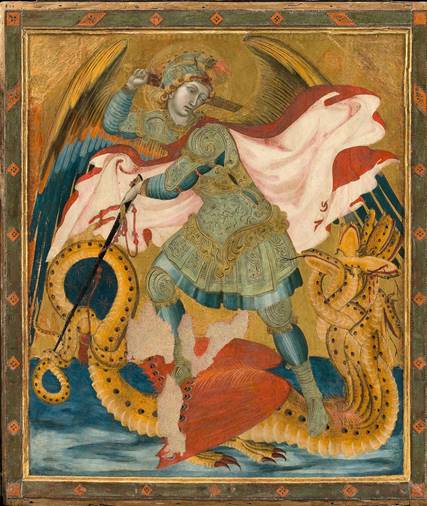
Ambrogio Lorenzetti’s colourful St George and the Dragon.
Along to the right, after another frescoed room, there are further paintings, including a good tryptich by Matteo di Giovanni (150 or so years after Lorenzetti) with the Virgin and Child flanked by Saints James and Augustine on the left and Saints Bernardino (instantly recognisable as usual) and Margaret on the right. The strange object that St Margaret holds in her hand is a miniature dragon; according to her legend, one of her many tortures was to be swallowed by a dragon that then burst asunder. Also in this room there is a striking tryptich of the Nativity by Pietro di Giovanni d’Ambrogio (1409/10-1448), an artist from whom very few works have come down to us. While within the conventions of the period, it manages to have a certain rural authenticity. The shepherds are particularly good, looking like real peasants even though they are accompanied by an unlikely lion-like dog. And note the excellent owl – the artist obviously liked animals. The saints on either side are Augustine on the left with a book, as befits a doctor of the church; and Galgano on the right holding his sword in the stone.

Detail of Pietro di Giovanni d’Ambrogio’s Nativity triptych.
In the next room of paintings there is a rather confused Coronation of the Virgin opposite by Giovanni di Paolo has rather better side-panels of Saints by Matteo di Giovanni.
We recommend that you pass rapidly through the second floor which has a number of undistinguished later works and the unimpressive first part of the archaeological collection. One room, however, has been given over to a painting of the Birth of the Virgin which may have somewhat wooden faces but is in the best tradition of Sienese decorative art, beautifully composed and with wonderful embroidered robes. The attribution has been much argued over but it is now considered to be by the 15th century Maestro dell’Osservanza, so-called because nobody knows his name and there is a painting by him in the church on the outskirts of Siena of that name (although the Asciano museum's Birth of the Virgin is probably his chef d’oeuvre). The Virgin is said to have been born to an elderly couple, Anna and Joaquim, who thought they were well past child-bearing and her birth is almost always represented in the same way in Sienese painting. The mother lies recovering on a bed to the right; mid-wives wash the newly born baby in the centre, and Joaquim sits outside on the left.
The best of the archaeological stuff is on the third floor and consists largely of 4th century BC Etruscan objects found in a nearby Etruscan burial site, including a lot of rather plain urns for the ashes of the dead. There are a couple of quite good Greek-style painted vases and a case of interesting bronze objects, including mirrors and a strainer, testifying to the sophistication of Etruscan society, but nothing of major interest.
There is another museum, the Museo Cassioli, devoted to the paintings of Amos Cassioli, a 19th century artist from Asciano best known for his frescoes in the Sala della Risorgimento in the Palazzo Pubblico in Siena, of little interest to most visitors.
2004; revised 2015.
------------------------------------------------------------------------------------------------------------------------------
MONTEPULCIANO
One of the larger south Tuscan hill towns with attractive churches and palazzi, a good main square and famous red wine. Another town with exceedingly steep streets.
Montepulciano lies to the east of Pienza. There are signs to car-parks at various points on the way up to the old town (where parking is restricted). The town is strung out along a sharply sloping ridge, so visitors have a choice between parking at the lower end by the Porta al Prato and the Piazza Sant’Agnese and struggling up to the top, or following the signs to Centro Storico and Fortezza and parking as near as possible to the Fortezza at the top end. We recommend the latter, even though it means going up hill on the way back, as it is nearer the Piazza Grande, the most attractive part of the town. There are usually some parking spaces just inside the town gate by the Fortezza, and another small car-park if you turn right in front of the Fortezza. Note that parking spaces with blue lines are paying; those with yellow lines are reserved for residents; and those with white lines (invariably the furthest away) are free.
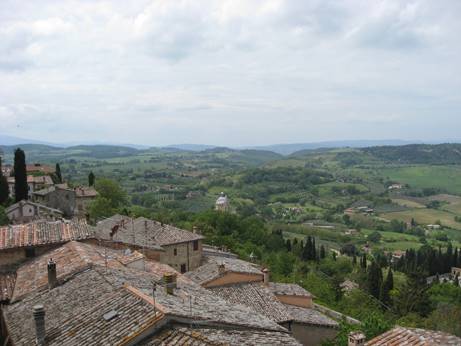
View from Montepulciano, a city of panoramic views
Montepulciano changed hands a number of times between Florence and Siena in the early days of its history, finally passing permanently to Florence in 1511. The Florentine rulers immediately set about making their mark by bringing in their most distinguished architects to build a large number of grand palazzi (some 60-70 years before the construction of neighbouring Pienza). The main square, the Piazza Grande, is one of the most attractive in the Senese, with its honey-coloured renaissance palazzi and town hall. None of the churches is outstanding, but most are worth a quick look (the main churches now have QR codes by their main works of art). The greatest architectural treasure is just outside the town, the temple of St Blaise. The town’s other great treasure is its heady, heavy red wine, the Vino Nobile di Montepulciano, said by many to be among the best in Italy.
If on a day trip, it is best to start with the town proper, and visit St Blaise (San Biagio) (which is open all day) on the way out.
Fortezza
If you start at the top end of the town, you will pass the Fortezza with its peaceful and shady garden. There was a castle here already in the eighth century called the Castello Politiano (otherwise Pulliciano, leading to the name Montepulciano. It was on the site of a Roman Temple of Mercury, and before then an Etruscan settlement. The Fortezza was rebuilt by the Sienese in the 13th century and subsequently again destroyed and restored at various periods, so it is now a bit of a mongrel. It usually houses a free temporary exhibition of some sort.
Piazza Grande
The Piazza Grande, at the top end of the town close to the Fortezza, is marred only by the unfinished façade and ugly campanile of the Duomo occupying one side of the square (although the campanile is actually 15th century and earlier than the rest of the Duomo, it looks more like a hideous remnant of Mussolini’s time). The Palazzo Comunale, the town hall, occupies another side of the square. It started life as a 13th century gothic structure, but was given a makeover by the Florentines in the 15th and 16th centuries, adding a tower so as to resemble the Palazzo della Signoria in Florence. The diminutive terrace below the tower is open to the public (small charge). Enter by the main door and take the stairs up to the left. There are the usual panoramic views over the surrounding countryside.
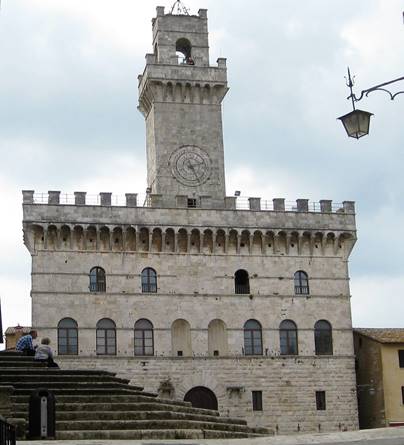
Palazzo Comunale
On the other side of the square stands the Palazzo Cantucci (now selling local wines), one of the best Florentine palaces. The bottom part was built by Sangallo the Elder (1455-1534), one of the architects who was sent by the Florentines to fortify and embellish the town after it passed into their hands. The top floor was added later. The best building on the square is opposite the Duomo: the Palazzo Tarugi, also by Sangallo, with a grandiose baroque travertine façade, unfortunately marred by the filling in of the arches on the top floor to create more rooms. Sangallo also designed the well in front of the Palazzo, which must count as one of the most attractive wells anywhere, with its Florentine lions and Medici pawnbroker’s balls matched by the Montepulciano griffon. Next to the Palazzo Tarugi stands the older but much restored Palazzo del Capitano del Popolo – Gothic windows to be seen clearly on the side going down the via Ricci.
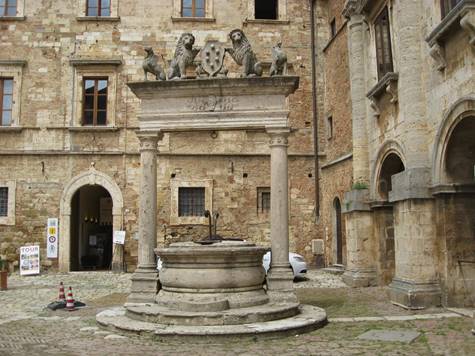
A most beautiful well-head
The Duomo
Usually open all day.
From the outside, the Duomo (built in the early 16th century) is disappointing, with its unfinished, raw-looking façade – it seems that the distinguished Florentine architects were being kept too busy building palazzi to get round to the churches. But it has an elegant classical interior, giving an impression of coolness and space. It contains several paintings and sculptures of interest. On either side of the main door there are tombs surmounted by the figures of their occupants. The most distinguished is on the left and is by Michelozzo di Bartolomeo Michelozzi (1396–1472), another of the Renaissance artists (he was both architect and sculptor) favoured by the Florentine Medici family. The subject is Bartolomeo Aragazzi, secretary to Pope Martin V. He is portrayed in gleaming Carrara marble, with a wonderful characterful face beneath a deep hood. The tomb was originally a much larger and no doubt wonderful structure that was broken up in the 1600s; the fragments were rediscovered only in the 19th century. Other fragments of it are to be found around the church – two bas-reliefs on the pillars of the nave nearest the door; the two marble statues of virtues on either side of the altar; the statue of (probably) Christ to the right of the altar; and the beautiful marble frieze immediately above the main altar table. Two other statues from the tomb are in the Victoria and Albert Museum in London.
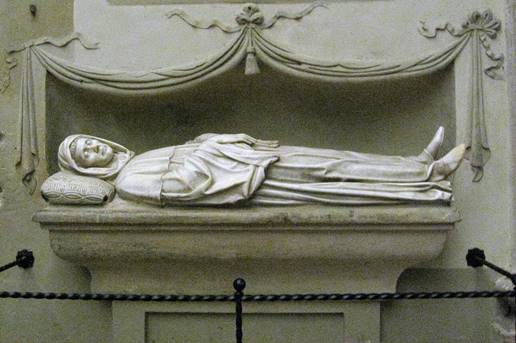
Tomb of Bartolommeo Aragazzi
In the first chapel of the left hand aisle, there is a good polychrome terracotta altar (1512) by Andrea della Robbia, portraying saints Stephen, Bonaventura, Catherine and Bernardino. On either side there are strongly carved statues of St Peter and St John the Baptist, attributed to Tino di Camaino (1280-1337), the Sienese sculptor who responsible for much of the work on the Duomo at Pisa; and below there is an elegant 14th century marble font. Further along in the same aisle, between the third and fourth pillars, there is a charming painting of the Madonna and Child – the Child with red hair and a beautifully painted robe – by Sano di Pietro (1406-81). Over the main altar there is a tryptich (1401) of the assumption by the Sienese artist Taddeo di Bartolo (commissioned during one of the periods of Sienese domination). Immensely colourful and crammed with figures, it gives a splendid glittering impression from afar, but is a bit of a muddle closer to unless one has binoculars to study the detail.
Museum
A little way down the via Ricci, in a red-brick gothic Sienese palazzo, there is a small picture gallery, the Museo Civico, with some Sienese paintings (not of tremendous interest), open 09.30-13.00 and 15.00-18.00 except Monday.
The Corso and the other churches
The main shopping street of the town is the Corso, or more properly successively via Voltaia nel Corso and via Gracciano nel Corso, running from the Fortezza at the top of the town down to the Porta al Prato. It is siuated well below the Piazza Grande and to reach it from the Piazza one needs to go steeply down to the end of via del Teatro, next to the Palazzo Cantucci.
The church on the right about half-way down the Corso, Gesu, has a baroque interior, alth ough money appears to have run out when they got to the side altars which have trompe l’oeil pillars, and it has yet another unfinished façade. Further on, also on the right going down, is the huge and grim Palazzo Cervino, now the headquarters of a bank. It was built in the heaviest possible rusticated style on one of Sangallo’s off-days for the future unlucky Pope Marcellus II (whose family name was Cervini) – unlucky because he died only 22 days after becoming Pope in April 1555, leading all Popes for the next four hundred years to avoid taking a name with a II in it.
A bit further down, by the pretty Loggia del Grano (1570), the Corso forks left and goes down to the churche of Sant’ Agostino (about 1427), the only church with a really fine marble façade, trying to be purely classical but betraying the odd Gothic touch still: pointed arches and the ghosts of crockets in low relief above the door. Its designer was the Florentine architect and aculptor Michelozzo (1396-1472), who also made the terra cotta relief of the Madonna and Child over the door. It has an attractive classical interior, but with so much else to see, it is not worth lingering. Opposite the church, there is a medieval tower with a grotesque commedia dell’arte figure of a clown who strikes the hours, more reminiscent of Germany than Italy.

The clock-tower
Other churches include Santa Lucia with an attractive travertine façade and inside, behind a grill on the right of the right hand altar, a rather beautiful tender-faced Madonna by Luca Signorelli (1441-1523); Sant’Agnese outside the Porta al Prato; and Santa Maria dei Servi the other end of town behind the Fortezza.
Tempio di San Biagio
Tickets must be purchased from an office round the side of the Canons' House (2022)
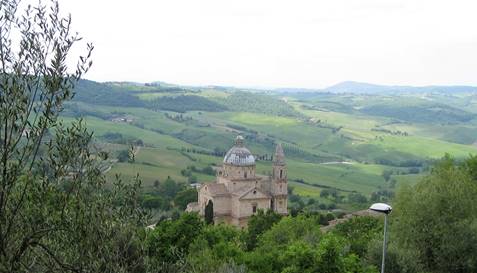
San Biagio seen from the town
The temple (in fact a straight church) of St Blaise, just outside the town, is one of the best buildings of the high Renaissance anywhere in Italy. In the form of a Greek cross, it was built of honey-coloured stone by Antonio Sangallo the Elder between 1518 and 1534 and is generally considered his master-work. Its beautifully carved interior encompasses almost every classical motif which the Renaissance drew from ancient Greece and Rome – rather like a text-book exercise in Renaissance design. Proportion and symmetry are all, marred only by the failure to complete the second tower - what was it about the inhabitants of Montepulciano that made them incapable of completing their churches? – and the baroque angels high above the main altar, who are dangling their feet over the arch below in a charming but most unclassical way.The interior is also marred by some large and undistinguished paintings that have been erected on frames in front of some of the side altars. There is a good echo, especially from the central point beneath the dome. The only thing remaining from the previous church on the site is the rather battered 14th century fresco of Virgin, Child and St Francis immediately above the main altar – it had a reputation for working miracles, so was given pride of place in the new church. According to legend, in 1518, people passing in front of the fresco saw that the Virgin’s eyes moved as if she were alive; later, other miracles occurred. This decided the locals that they needed a new church to house the miraculous painting.
The beauty of the church is enhanced by its setting, unusually for Italy in the middle of a green field with a well and a nearby loggia (the Canons’ house), dating from about the same time as the church.
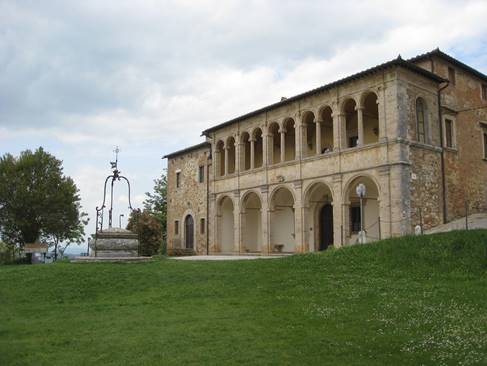
The Canons’ house
1995, revised in 2003, 2016 and 2022..
------------------------------------------------------------------------------------------------------------------------------
PIENZA
A perfect small medieval town, built to order by a pope whose birthplace it was.
Pienza was originally an empty site near a small village called Corsignano. Aeneas Sylvius Piccolomini, who later became Pope Pius II (in whose honour the Piccolomini Library in Siena was built), was born there in 1405, the son of the local landlord. When he became Pope in 1458, he renamed the village Pienza in honour of himself, built a brand new cathedral church and a palazzo for his own use and invited his friends to build their own houses there. He employed a Florentine architect, Rossellino, and almost everything in the little square in front of the church is designed by Rossellino, including the handsome town hall (Palazzo comunale) opposite and the well to one side. Being all of one period, the town has an unusual stylistic unity and is often used as a film set when a romantic renaissance setting is called for.
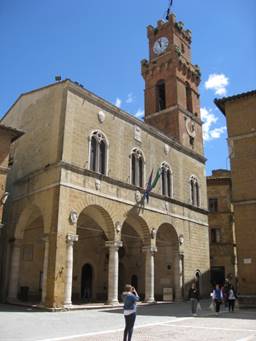 The Town Hall The Town Hall
|
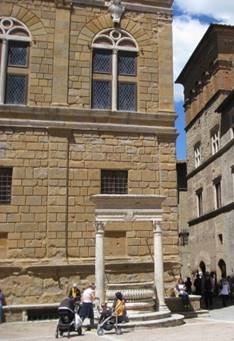
The well with the Palazzo Piccolomini behind |
The Cathedral (Duomo)
The cathedral has a particularly handsome classical façade and is wonderfully light and airy inside, because of its white painted walls and three naves of equal height (a Germanic style unusual in Italian churches). Note the Piccolomini crest of a crescent moon incorporated in the tracery of some of the windows. Unfortunately the site was badly chosen for such a large structure, and the chancel end of the church is built on uncertain foundations on the hillside, down which it shows alarming signs of slipping – the floors at that end slant noticeably and there are great cracks in the walls.

The Duomo
Pius II employed the best Sienese painters of the period to produce five paintings for the church. On the left (north) wall, there is a colourful “Madonna with Saints” (St Jerome and three bishops, Martin, Nicholas and Augustine) by Matteo di Giovanni (c.1435-95); above the altar to the left of the main altar, there is a more serene “Madonna with Saints” by Sano di Pietro (1406-81), the figures standing unusually on a wholly carpeted floor and with magnificent red and gold draperies thrown over the throne; and in the final chapel on this side there is an Assumption by Lorenzo di Pietro (usually known as Il Vecchietta (1410-1480) – a particularly dynamic portrayal of the Virgin rising into the sky, accompanied by numerous angelic hangers-on, all being impelled upwards as if by a jet of hot air. The saints on either side are, from left to right, St Agatha (whose martyrdom is said to have included the cutting off of her breasts, which she carries rather distressingly on a plate); Pope Pius I; Calixtus; and St Catherine of Siena with her lily. In the chapel past the main altar on the right, there is a fine sculpted travertine tabernacle designed by Rossellino, a masterpiece of Renaissance elegance (he also designed the equally elegant font in the church). Over the next altar to the right is another colourful and expressive “Madonna with saints” by Matteo di Giovanni, compared to which the final painting further along the right wall, yet another “Madonna with Saints” by Giovanni di Paolo (1403-82), although contemporaneous, appears dark, stiff and old-fashioned.
Palazzo Piccolomini
Opening hours 10.00-12.30 and 15.00-18.00. Closed on Mondays.
On the other side of the little square stands Pius II’s own palace – although in fact it was not finished until after his death. It is a handsome Renaissance building with a courtyard in the middle. Only the first floor is visited, and visitors must join a guided tour, unfortunately only in Italian. There is nothing particularly special in the palace, and little dating from the time of Pius II – most of the furniture is 17th century. Nevertheless, even for non-Italian speakers, it is worth the visit for a good impression of the typical interior of a large palace that was lived in fairly recently – it was still a Piccolomini family residence until the 1960s.
The dining room on the right of the entrance has some pretty furniture. On the other side of the entrance, the Music Room is the only room to have its original ceiling. There are handsome 16th century Spanish hangings on the walls, and a secretaire which at first sight seems to be covered in faded sepia postcards of views of towns – on closer inspection, these prove to be pieces of natural stone. The table in the middle of the room bears a map of the province of Siena in the days when it included Grosseto.
Next door is the main room of the palazzo, the Sala d’Armi, the walls hung with antique arms. It has a magnificent carved Renaissance fireplace and a wonderful balcony looking out onto the countryside. What was intended as the Pope’s own bedroom is beyond, with an opulent if anachronistic baroque bed. The only piece of furniture in the palace which might have actually belonged to Pius II is the inlaid chest in this room. A passage with a secretaire positively bristling with secret doors leads to the library, the best room in the house. Down another corridor, the notice put up by the German occupying forces during the Second World War, declaring the palace to be a protected cultural treasure, has been preserved.
The Diocesan Museum
In the old Bishop’s palace to the left of the cathedral; entrance in the main street. Open 10.00-13.00 and 15.00-18.00; closed on Tuesday.
This has one particular treasure, Pius II’s English cloak or cope; and a good little collection of early Sienese paintings gathered in from surrounding churches, as well as quite a lot of boring vestments and ecclesiastical metalwork.
Room 1, to the left at the top of the stairs, has on the wall to the left of the door a particularly pretty little portable tryptich (presumably for travelling) by the “Master of the Osservanza” (14th-15th century), and on the end wall a large “Madonna della Misericordia” by Bartolo di Fredi (c.1330-1410) – just as in churches in those days the women sat on one side and the men on the other, so the people sheltering under her cloak are segregated according to sex. The two polychrome wooden statues by the 15th century Domenico di Niccolo dei Cori are of St Regalo (carrying his head to make sure nobody forgets that he was beheaded) and St Leonard.
Room 2 has more early Sienese paintings, including one real treasure, the Madonna and Child by Pietro Lorenzetti (c.1280-1348) on the left wall. The figures still have the strange almond eyes of Duccio and Simone Martini, but with infinitely more feeling and movement as they stretch affectionately towards each other.
Passing rapidly through Room 3 (tapestries), one comes to Room 4, dedicated to the English-made cope. In the 13th and 14th centuries, English embroiderers were famous throughout Europe for their work, known as “opus anglicanum”, and to own such a cope was a must for the rich churchman who had everything. There are several examples of opus anglicanum in the Victoria and Albert Museum in London, but none so fine as this cope. Unfortunately, it has been hung to high to see the detail at the top, and the dim light necessary for conservation – does not help. But as far as it is possible, it is well worth studying in detail, even for those for whom embroidery and church vestments are usually a turn-off.
The embroidered decorations on the cope are in three concentric circles. The inner one shows five scenes from the life of the Virgin; and the next one a further nine scenes from her life interspersed with pictures of Old Testament ancestors of Christ. The outer circle shows scenes from the lives of two saints, St Margaret of Antioch and St Catherine of Alexandria. The work is incredibly fine with many lively details – like the goat eating a bit of a bush in the middle circle.
Room 5 has bits and pieces from the time of Pius II and a large painting of the Virgin with Saints by Il Vecchietta on an off-day – although the Annunciation in the lunette above is an attractive exercise in perspective. Room 6 contains 16th century works of which the main thing worth looking at is the painting by Fra Bartolommeo of the Holy Family resting during the flight to Egypt to escape Herod’s massacre of boy babies. Although the draftsmanship leaves to be desired, it immediately makes an impression with its vivid colouring and strong figures. The remaining rooms have little of interest.
The rest of the town
The whole town is a pleasure to walk round, with its neatly kept streets and flowery courtyards. There is also a walk with spectacular views along the walls behind the cathedral. Most of the shops sell pecorino, the excellent sheep’s cheese that is a Pienzan speciality – it comes in various degrees of maturity from a fresh soft version to a hard and strong tasting one. Almost the only building remaining from before Pius II’s time is the little Gothic church on the main street; it is not of much interest, except for the magnificent presepio (crib) made by a modern master of glazed terracotta (Italian churches delight in competing with each other to produce the most elaborate crib). Next door is a cloister where an expensive meal can be had.
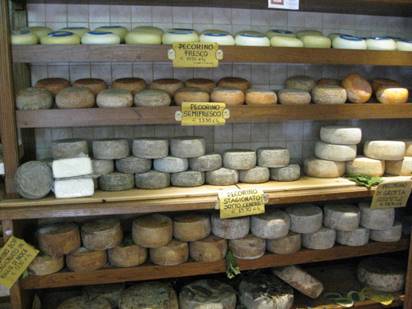
Pecorino on sale in Pienza (photo 2014)
*************************************************************************************
CORSIGNANO
Those who like really ancient buildings should not miss the Pieve di Corsignano, the original parish church where Pius II was christened. Go out of the town through the southern gate and down the little road past the Il Prato restaurant, turning right at the bottom (about 600 metres altogether). On the right is an ancient fountain or spring, and on the left a little early Romanesque church (10-11th century) with the most amazing carvings round both the main doorway and the door in the South wall. The latter has the three Magi riding across its top, but the figures on the main door seem entirely pagan, especially the fertility type figure forming the central mullion of the window above the door. These may be ancient Lombard designs, as may the carved stone screens on either side of the altar in the church. The whole structure, with its strange round tower and massive square stone pillars inside, gives the impression of emerging from the deep dark ages. The font in which Pius was christened is still inside, perched on an old Romanesque capital.
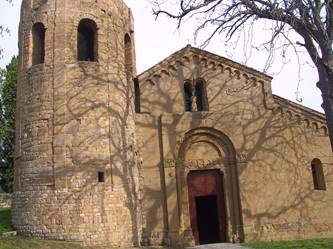
Revised 2003 apart from the section on the Palazzo Piccolomini which dates from the early 1990s.
***********************************************************************
SANT’ANNA IN COMPRENA
A little visted monastery with frescoes by Sodoma
A couple of kilometres before Pienza when approaching from San Quirico d’Orcia, there is a turning to the left signposted to Sant’Anna in Camprena and Castelmuzio. The monastery of St Anna in Camprena is about 5km along this road, on the left. What remains of the monastery buildings is now an “agriturismo”in private hands and the refectory with the Sodoma frescoes is currently(2022) only open to those staying at the agriturismo or by appointment (telephone 0039 0578 748037).
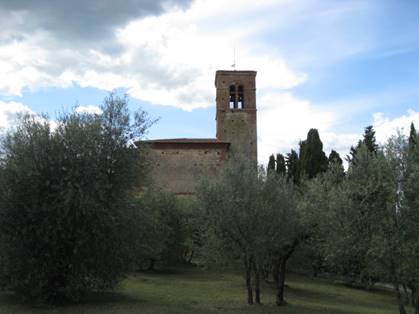
The monastery of St Anna in Camprena, beautifully set among cypresses and olive groves, was an off-shoot of the Benedictine monastery of Monteoliveto Maggiore. It was founded in the early 1300s, but the present buildings date from some 100-150 years later. It is dedicated to St Anne, the mother of the Virgin Mary. Part of the film The English Patient was shot there.
In 1503 the monks invited the 25-year-old painter Giovanni Antonio Bazzi – more usually known as Il Sodoma – to paint frescoes in their refectory. It was his first big commission and obviously impressed the monks enough for them to invite him a few years leter to complete the big cycle of frescoes of the life of St Benedict in the cloister of the mother house at Monteoliveto Maggiore. Only some of the frescoes at St Anna survive, but they show him already to be a master of vivid colour and attractive characterisation. They also show his love of landscape and of animals – he could never resist inserting a dog or wild animal into his works.
On the entrance wall, the fresco on the left shows the Bishop of Arezzo approving the Rule of the Olivetan Order. The central fresco is a moving depiction of the Deposition of Christ which includes both St Anne (in black) and her husband St Joaquim comforting the Virgin and St Mary Magdalen on the left. The final fresco portrays the Madonna and Child with St Anne standing behind her – hand tenderly on the Virgin’s shoulder – and two Olivetan monks in their white habits kneeling reverently on either side.
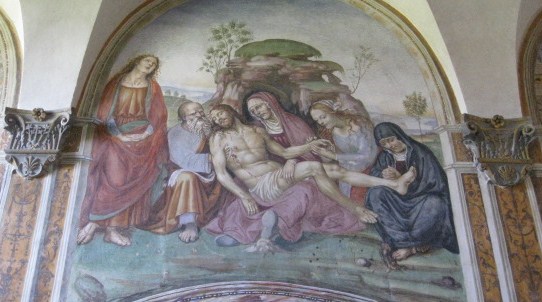
The Deposition, with Sts Mary Magdalen, Joaquim and Anne.
The frescoes on the other end wall tell the biblical story of the Multiplication of the Loaves and Fishes. After the death of St John the Baptist, Jesus and his disciples withdrew to a remote place. Crowds of his supporters followed, and when evening fell, Jesus told his ciscplies to feed them. But they had only five loaves and two fishes. Jesus miraculously transformed these into sufficient to feed the multitude. The first fresco shows the little food available being collected together (lots of almost empty baskets); the second shows a boy holding up the fives loaves that have been found, which Jesus blesses; and the third – unfortunately damaged – shows the distribution of the miraculously multiplied bread. Note the dogs at the bottom of the first two frescoes.
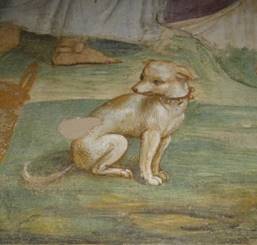
|
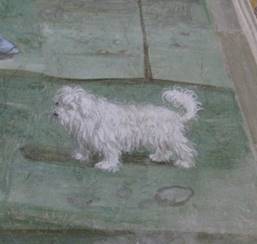
|
The inner side wall is also decorated with frescoes by Sodoma with saints, grotesques, cherubs and fantastical animals. This decoration is heavily influenced by that in the Golden House of Nero in Rome, which had recently been rediscovered after having been buried since Roman times.
(2014 and 2022)
**************************************************************************
MONTICHIELLO
About 5 kilometres from Pienza, this is an optional extra for anybody who wants to see more before leaving the area. Not much time is needed.
Montichiello is a largely unspoilt fortified mediaeval village on a hilltop, from which there are good views back to Pienza. It has walls, a watchtower with battlements and a good church, dedicated to Saints Leonard and Christopher. The church was built in the 14th century and is very simple on the outside apart from a most elegant Gothic main doorway. Inside, there are a number of quite interesting if somewhat fragmentary 14th and 15th century frescoes by Sienese artists, including a huge St Christopher to the left of the altar. The church used to contain the Madonna and Child by Pietro Lorenzetti now in the Pienza museum, and displays a reproduction where it used to be (they must have been extremely cross in Montichiello when it was removed, although doubtless on good grounds of security as there have been many thefts of artworks from Italian churches).
The other attraction of Montichiello is that it has two eating places which are less touristy than those of Pienza. The cheaper one at the entrance to the village has a terrace with excellent views; the more expensive one, Taverna di Moranda, is said to have excellent food (closed on Mondays).
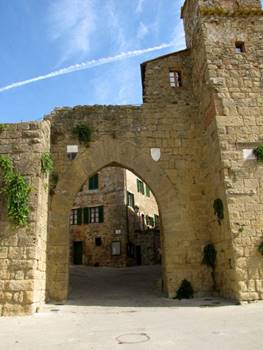
2003
*******************************************************************************************************************************
CHARTERHOUSE (CERTOSA) OF PONTIGNANO
A former Carthusian monastery in the Chianti with impressive cloisters, just north-east of Siena.
The monastery is a few kilometres outside Siena along a well-marked turning off the via Chiantigiana, the main road from Siena to Gaiole in Chianti – quite complicated to get to from Barontoli, but worth a visit if you are in the Chianti. After parking in the visitors’ car-park, go to the reception and ask to visit the cloisters. They may ask for one of the party to leave a passport or other identity document, and will then press a button allowing access to the cloisters. The reception is open all day if a conference is taking place, but may close for lunch at other times.
This former Benedictine monastery (also sometimes known as the Certosa di San Pietro) set in an olive grove was founded in 1343. Its position outside Siena’s city walls made it vulnerable to attack by marauding Florentines. In 1554 it was sacked after having been captured by British and German mercenaries fighting for Florence. The present Renaissance style buildings were those erected in the decades after the sacking. It continued operating as a monastery until 1810, when it was formally closed and its land and property sold off. The buildings (but not the church) now belong to the University of Siena, and it is used as a conference centre, with delegates being accommodated in the former monks’ cells, updated to have en-suite bathrooms. It also offers hotel accommodation.
The buildings consist mainly of two large cloisters. The cloisters are surrounded by the cells of the monks in a typical Carthusian fashion – the Carthusians are a closed order and the monks spend most of their time in their cells in contemplative prayer. The first or main cloister is the smaller of the two, but is grander and was where the full members of the Order lived. Lesser fry in the form of lay brethren and new acolytes lived round the second, larger cloister. Both cloisters retain remains of trompe-l’oeil frescos of colonnades which must once have looked very fine.
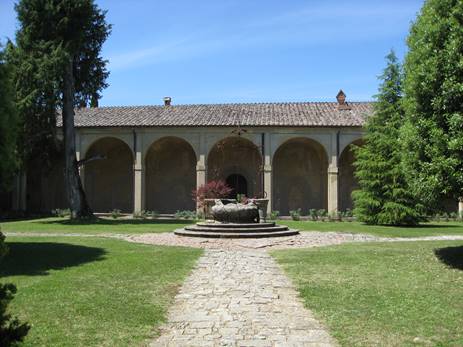
The main cloister
The monks’ refectory, complete with the standard fresco of the Last Supper, is now the main conference room. Opposite the entrance to the main cloister there is a central door leading to a loggia overlooking a well-tended formal “Italian Garden”, in which the former monks’ fishponds or water-tanks can be seen.
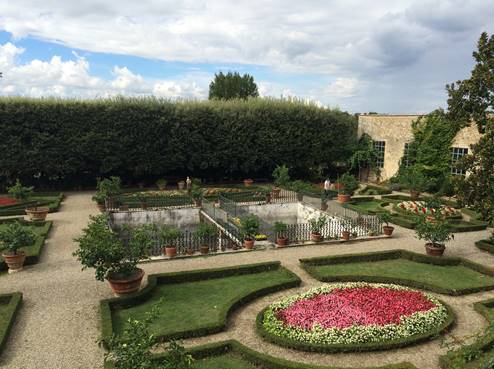
The Italian garden
There is a door off the main cloister into St Peter, the former monks’ church. The church belongs to the parish, so is nothing to do with the University, but the door is often open. The church seems to have survived the sack and externally retains its medieval character. Inside it was richly decorated in the late 16th-early 17th centuries with lots of wood and marble carving, and above all the walls and ceiling were completely covered with frescoes, mostly dating from 1579, of the life of Christ and his Mother, and of the history of the Carthusian order and its founder St Bruno.
2016
----------------------------------------------------------------------------------------------
TORRITA DI SIENA
A small walled town some 15 kilometres beyond Montepulciano with some interesting churches.
This small fortified town was a defensive post on the frontier of Siena’s domains, important in Siena’s struggles with Montepulciano and rebellious local nobles. In the Sala del Mappamondo in Siena’s Palazzo Pubblico, there is a wonderful frieze by Lippo Vanni of the battle of Val di Chiana in 1363, a famous Sienese victory against a company of mercenaries (backed by Florence, but apparently on this occasion intent on some private plunder) that took place near Torrita; the latter is one of the towns shown along the top of the painting. In 1554, Torrita was conquered by Florence and came under the rule of the Medici, who have left their crest with pawnbroker’s balls on the tower of the Palazzo Comunale. The city was walled, with four gates leading into it. Only part of the walls remains, but the four gates are still there, three dating back to the 13th century (the Porta Nova was rebuilt in the 19th century).
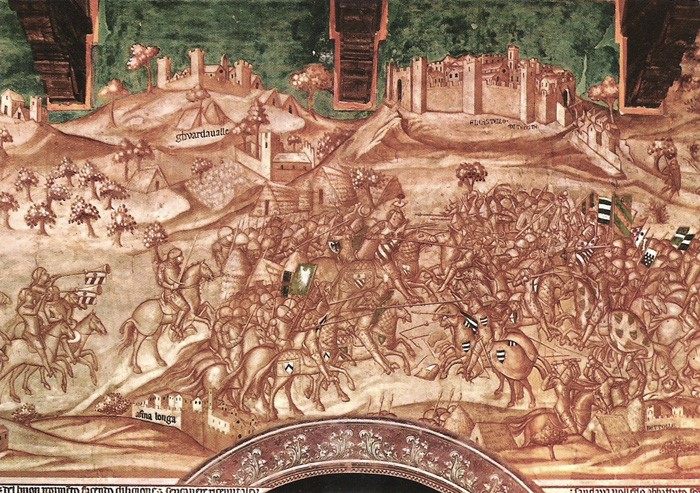
Now it is a quiet backwater. Its mediaeval streets are lined with buildings in an attractive shade of red brick. The Palazzo Comunale was on the main – or indeed only – square, Piazza Matteotti, but little remains of it today but its tower (there is a helpful tourist office at the base of the tower which can provide a map). However, the tiny city has no fewer than nine churches, some of which have interesting frescoes or sculptures.
Church of Santa Flora and Santa Lucilla
The first, on Piazza Matteotti two doors away from the tower of the Palazzo Comunale, is the Romanesque church of Santa Flora and Lucilla. The latter are two particularly obscure saints - just two of twenty-four virgins and martyrs killed by the Romans in 260 – and there are only three churches dedicated to them, all in Tuscany. It seems that the relics of these two virgins were transferred in 851 from Ostia to Arezzo (where a large abbey church is dedicated to them) and from then on were considered special to Tuscany.
This is Torrita’s oldest church within the walls, with a pretty doorway in an unassuming brick façade. It houses a little-known carved marble panel or “lunette” dating to 1430 by the great Florentine sculptor Donatello, originally from above a door in another church. In the 1920s, the panel was stolen and a local sculptor commissioned to make a copy, presumably from photographs. The stolen panel was then recovered and the original and copy are now displayed one above the other in a glass case just inside the church. The subject is the “Blood of the Redeemer”, a somewhat gruesome subject quite often found in Italian painting, showing Christ after his death and resurrection, with angels catching the holy blood from the would in his side. There are other works worth a glance in this tiny church, including on the left side wall a typically colourful tryptich by Bartolo di Fredi (1330-1410) of the Nativity, complete with shepherds and sheep dog, with Saints Anthony Abbot and Augustine on the side panels. On the inside of the façade there is a 15th century fresco of St Francis receiving the stigmata.side.
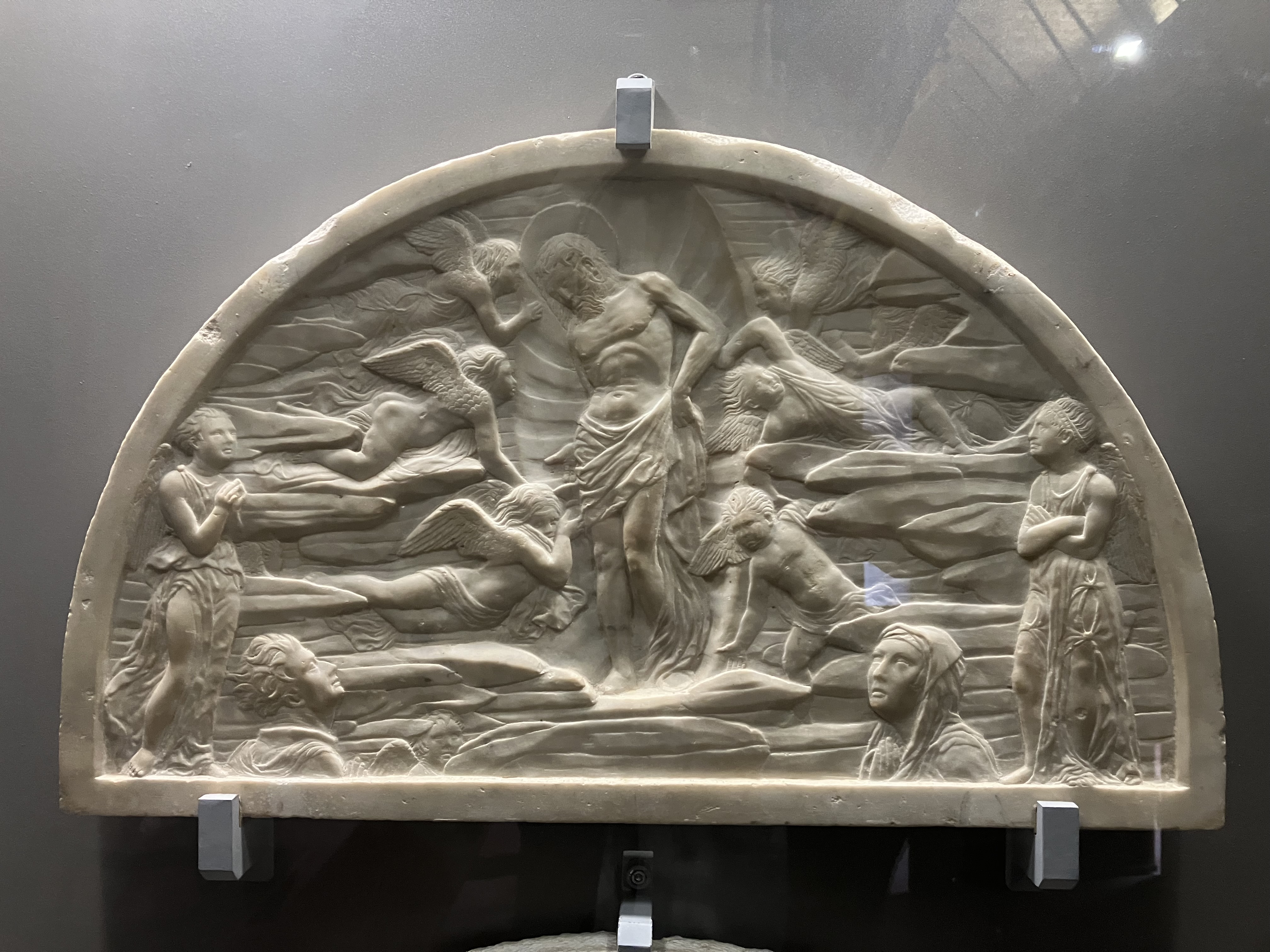
Donatello's lunette at Torrita
There are other works worth a glance in this tiny church, including on the left side wall a typically colourful tryptich by Bartolo di Fredi (1330-1410) of the Nativity, complete with shepherds and sheep dog, with Saints Anthony Abbot and Augustine on the side panels. On the inside of the façade there is a 15th century fresco of St Francis receiving the stigmata.

St Francis receiving the stigmata, Torrita
Oratory of the Madonna of the Snows (delle Nevi)
This church is just outside outside the walls. It is called after a miracle whereby the Virgin miraculously caused show to fall in summer in Rome, showing where a church should be built. It was erected after the citizens of Torrita begged the Virgin to stop an attack of the plague in 1525 and there were no more victims after the feast day of the Madonna of the Snows. The church itself is unremarkable and one cannot enter it. But one can peer through a glass screen at a large fresco covering the wall above the alter by the Sienese artist Girolamo di Benvenuto, painted around 1500 and remarkable for the huge number of personages portrayed – seventy-six saints and angels have been counted and the inhabitants of Torrita consider it their own Sistine Chapel. The central figure is the Virgin being assumed into heaven and casting her belt down to St Thomas. Unfortunately, only the central part is properly lit and it is difficult the see the saints around the outside of the ensemble.
.jpg)
Madonna alle Nevi, Torrita
Other Churches
The other churches within the city walls are San Martino e Constanzo (the largest); the Church of the Holy Cross (Santa Croce) and the Church of the Annunciation (Santissima Annunziata). There are panels outside in Italian and English with brief descriptions. All have handsome baroque interiors full of statues and marble. Above the high alter in the church of the Annunciation there is a large and brightly coloured painting of the event (with a benevolent God the Father presiding from above) by Francesco Vanni dating from 1592.
The most important event in the calendar of Torrita di Siena is the "Palio dei Somari", a race with donkeys instead of horses, on the Sunday following 19 March, the day of St Joseph, the town’s patron siant.
2022